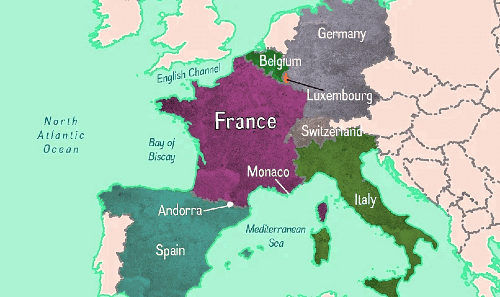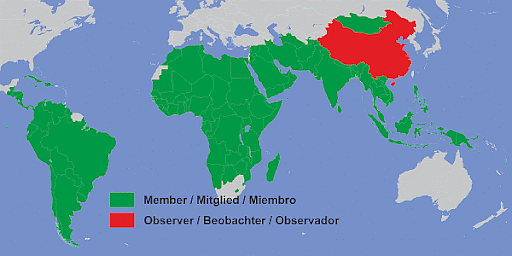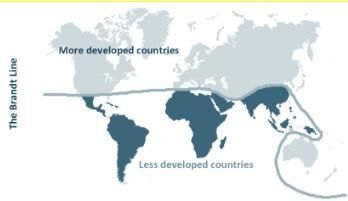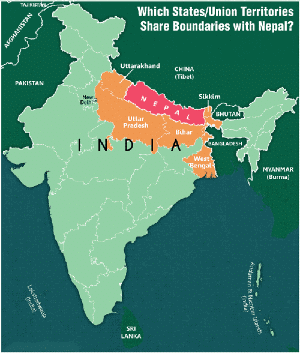International Relations - 1 | Current Affairs & Hindu Analysis: Daily, Weekly & Monthly - UPSC PDF Download
| Table of contents |

|
| India-France Relations |

|
| Third South Summit |

|
| India-Bangladesh Relations |

|
| India-Nepal Power Pact |

|
| INDUS-X Summit 2024 |

|
| Iran-Pakistan Relations and the Baloch Militancy |

|
India-France Relations
Why in news?
Recently, the President of France visited India during the Republic Day celebrations on January 26, where both nations discussed enhancing bilateral cooperation, particularly in the context of joint defense exercises, which have become more complex and interoperable.

Key Highlights of the India-France Bilateral Meeting:
- Intensification of Cooperation in Southwest Indian Ocean: Both nations agreed to enhance collaboration in the Southwest Indian Ocean, building on previous joint surveillance missions conducted from La Reunion in 2020 and 2022. This partnership aims to secure important sea routes.
- Indo-Pacific Partnership: Emphasizing the Indo-Pacific's significance for their strategic interests, both countries committed to deepening their partnership based on shared goals and expressed satisfaction with their growing engagements in the region.
- Defence and Security Partnership: The defence and security collaboration in the Indo-Pacific was highlighted as pivotal, encompassing various bilateral and multinational initiatives, particularly in the Indian Ocean region.
- Trilateral Cooperation: They committed to revitalizing trilateral ties with Australia and enhancing partnerships with the UAE, including initiating the first India-France-UAE Maritime Partnership Exercise in June 2023.
- Economic Development and Connectivity: Both nations recognized the importance of joint initiatives in promoting sustainable economic growth, environmental sustainability, and innovation. They advocated for the prompt launch of the Indo-Pacific Triangular Development Cooperation Fund to boost green technologies.
- India-Middle East-Europe Corridor (IMEC): The leaders acknowledged the strategic importance of the IMEC for enhancing trade and energy flows between India and Europe.
- Multilateralism and UN Reform: They advocated for effective multilateralism and reform of the UN Security Council, with France reaffirming its support for India’s permanent membership at the UNSC.
- Defence Industrial Cooperation: Both countries expressed their commitment to strengthening defense industrial links and explored opportunities for co-design and co-production of defense equipment for India and other friendly nations.
- Tata Group and Airbus Agreement: An agreement was signed for developing and manufacturing civilian helicopters and expanding cooperation on the C-295 Transport Aircraft in Gujarat, aiming for significant local production.
- Shakti Jet Engine Deal: Ongoing discussions with Safran regarding the Shakti jet engine, focusing on specifications that align with future Indian fighter jet requirements.
- CFM International and Akasa Air: French jet engine manufacturer CFM announced a deal with Akasa Air for over 300 LEAP-1B engines for 150 Boeing 737 MAX aircraft.
- Space Cooperation: They launched the Strategic Space Dialogue and signed an MoU for satellite launch missions between ISRO’s New Space India Limited and Arianespace, emphasizing co-development and manufacturing of satellites.
Major Areas of Cooperation between India and France:
- Pillars of Relationship: The India-France strategic partnership, established in 1998, is based on mutual respect, non-interference, strategic autonomy, and a commitment to avoid involvement in each other's alliances.
- Defence Partnerships: The defence relationship is central to Indo-French ties, with France offering advanced defense technology and equipment, such as the Rafale deal and the construction of Scorpene-class submarines.
- Joint Exercises: Notable joint military exercises include Exercise Shakti (Army), Exercise Varuna (Navy), and Exercise Garuda (Air Force).
- Similarity in Stand on NATO+ (Plus): France publicly opposed NATO+ partnerships that would include nations like Australia and India, aligning with India's stance that NATO does not apply to its strategic framework.
- Economic Cooperation: Bilateral trade surged to USD 13.4 billion in 2022-23, with India exporting over USD 7 billion. France ranks as the 11th largest foreign investor in India.
- Cooperation at International Forum: France supports India's bid for permanent UNSC membership and entry into the Nuclear Suppliers Group.
- Climate Cooperation: Both countries are committed to combating climate change, demonstrated through the launch of the International Solar Alliance in 2015.
Challenges Between India-France Relations:
- FTA and BTIA Stagnation: The lack of a Free Trade Agreement limits trade potential, compounded by slow progress on the India-EU Broad-Based Trade and Investment Agreement.
- Differing Defense and Security Priorities: Although their defense partnership is strong, differing priorities can complicate cooperation, particularly with India's non-aligned stance.
- Intellectual Property Rights Concerns: France has raised issues regarding inadequate protection of intellectual property rights in India, which can deter French businesses.
- Trade Imbalance and Dominance of Defense Products: A significant trade imbalance exists, heavily skewed towards defense products, complicating efforts for a more diversified economic relationship.
- Barriers to Indian Products in France: Indian exports face challenges due to Sanitary and Phytosanitary measures, which can hinder market access.
- Student Mobility: Plans to welcome 30,000 Indian students to France face challenges related to visa processes and cultural integration.
- Human Trafficking Concerns: Incidents like the Nicaragua flight case raise concerns about transnational crimes, necessitating enhanced cooperation for safety and well-being.
Way Forward
- Both nations can support each other in shaping the international order and balancing dependencies.
- The Indo-Pacific framework is crucial for strengthening Franco-Indian relations, given France's interests in Indian Ocean stability due to its territories in the region.
- Collaborative efforts should focus on connectivity, climate change, cybersecurity, and advancements in science and technology.
Third South Summit
Why in news?
Recently, the Third South Summit was held in Kampala, Uganda, gathering members of the Group of 77 (G77) and China. The summit aimed to enhance South-South cooperation in areas such as trade, investment, sustainable development, climate change, poverty alleviation, and the digital economy. The theme for this summit was "Leaving No One Behind."

What is Group of 77 (G77)?
- Establishment: The Group of 77 (G-77) was formed on June 15, 1964, by the signatories of the "Joint Declaration of the Seventy-Seven Developing Countries" during the first session of the United Nations Conference on Trade and Development (UNCTAD) in Geneva. The group consists of 134 members, excluding China, which considers itself a partner providing political and financial support.
- Aims: The G-77 serves as the largest intergovernmental organization representing developing countries within the UN, facilitating collective economic interests and enhancing negotiating power on international economic issues.
- Structure: The G-77 is coordinated by a Chairman, who acts as the group's spokesperson. The chairmanship rotates annually among different regions—Africa, Asia-Pacific, Latin America, and the Caribbean. Currently, Uganda holds the chairmanship and coordinates G-77 actions within the African chapter.
- Chapters: The G-77 operates through various chapters located in Geneva (UN), Rome (FAO), Vienna (UNIDO), Paris (UNESCO), Nairobi (UNEP), and Washington, D.C. (IMF and World Bank).
South Summit:
- Decision-Making Body: The South Summit is the highest decision-making authority of the G-77. The first and second summits took place in Havana, Cuba, in 2000 and Doha, Qatar, in 2005, respectively.

Key Highlights of the Third South Summit Outcome Document:
- Call for Peace: Member countries stressed that sustainable development cannot exist without peace, advocating for a fair resolution to the Palestinian-Israeli conflict.
- Universal Agenda Implementation: The document reaffirmed the commitment to global agendas, including the 2030 Agenda for Sustainable Development, Addis Ababa Action Agenda (AAAA), Paris Agreement on climate change, and the New Urban Agenda (NUA).
- Poverty Eradication: The summit underscored poverty eradication as the foremost global challenge and essential for sustainable development, urging developed nations to strengthen international cooperation.
- Strengthening Institutions: The need to enhance the role of the UN General Assembly (UNGA) and Economic and Social Council (ECOSOC) in reforming the international financial architecture was highlighted, proposing deep reforms to address failures in the global financial system.
- Climate Finance Contributions: Member countries called for significant contributions to climate finance, including a commitment of USD 100 billion annually and doubling adaptation finance by 2025.
- Financing Needs and Debt Solutions: There was a call for Multilateral Development Banks (MDBs) to support developing countries with concessional financing and grants, advocating for debt swaps aligned with Sustainable Development Goals (SDGs).
- Urgent Reforms for Inclusion: Leaders emphasized the necessity for reforms in multilateral organizations to recognize the Global South's significance, advocating for an inclusive and equitable international financial system.
What is Global South?
- Definition: The Global South is often misconstrued as merely a geographical term; it represents a diverse group of countries facing developmental challenges, regardless of their actual geographic location. Notably, many countries considered part of the Global South, such as India and China, are located in the northern hemisphere.
- Historical Context: The Brandt Line, proposed by former German Chancellor Willy Brandt in the 1980s, illustrates the north-south economic divide based on per-capita GDP, symbolizing disparities that include regions of Africa, the Middle East, India, and China while excluding Australia and New Zealand.

Resurgence of Global South:
- Economic Dynamics: The COVID-19 pandemic highlighted existing economic disparities, significantly affecting Global South countries due to inadequate healthcare and disrupted supply chains, emphasizing the need for sustainable economic development.
- Shifts in Trade: The reevaluation of global supply chains due to the pandemic and geopolitical tensions, such as the Russia-Ukraine conflict, has prompted Global South economies to adapt and restructure their production centers.
- Geopolitical Realities: The collective voice of the Global South has gained prominence in international forums like the G20, reshaping global power dynamics and encouraging greater attention to their perspectives.
- Climate Vulnerability: Countries in the Global South are disproportionately affected by climate change, leading to discussions on adaptation, resilience, and the necessity for equitable global climate initiatives.
- Focus on Sustainability: The Global South's commitment to sustainable development and renewable energy has garnered international support, promoting environmental conservation efforts and investments.
India-Bangladesh Relations
Why in news?
Recently, the Prime Minister of Bangladesh, Sheikh Hasina, was re-elected for a historic fourth consecutive term. India was among the first nations to extend congratulations, showcasing the strong bilateral ties shared between the two countries.
How Have the Ties Between India-Bangladesh Flourished?
Historical Ties:
- The relationship between India and Bangladesh was significantly shaped during the 1971 Bangladesh Liberation War, where India played a crucial role by providing military and logistical support to Bangladesh in its struggle for independence from Pakistan.
- However, relations deteriorated in the years following independence, particularly during the mid-1970s, due to rising anti-India sentiment driven by issues such as border disputes and water sharing conflicts.
- With Sheikh Hasina's rise to power in 1996, a new chapter began in bilateral relations, marked by a treaty on Ganga water sharing.
- Since then, India and Bangladesh have fostered cooperation in areas such as trade, energy, infrastructure, connectivity, and defense.
Economic Cooperation:
- Bilateral trade between India and Bangladesh has witnessed consistent growth over the past decade, with Bangladesh becoming India's largest trading partner in South Asia.
- In the fiscal year 2021-2022, bilateral trade reached USD 18 billion, a significant increase from USD 10.8 billion in 2020-2021, despite a decline in 2022-2023 due to the Covid-19 pandemic and the Russia-Ukraine conflict.
- India ranks as the second largest trading partner for Bangladesh, with Indian exports amounting to USD 2 billion.
- In 2022, both countries completed a joint feasibility study for a Comprehensive Economic Partnership Agreement (CEPA), which is crucial as Bangladesh is expected to lose its Least Developed Country (LDC) status after 2026, resulting in the loss of duty-free and quota-free access to Indian markets.
- Bangladesh is keen to finalize a Free Trade Agreement (FTA) with India, while also pursuing the China-backed Regional Comprehensive Economic Partnership (RCEP), raising concerns for India.
Infrastructure:
- Since 2010, India has provided over USD 7 billion in Lines of Credit to Bangladesh.
- Key issues have been resolved, such as the Land Boundary Agreement (LBA) in 2015 and maritime disputes regarding territorial waters.
- In 2023, the Akhaura-Agartala Rail Link was inaugurated, enhancing connectivity between Bangladesh and India's northeast through Tripura, facilitating cargo movement through Chattogram and Mongla ports.
- This rail link is expected to boost small-scale industries and development in Assam and Tripura.
- The BIMSTEC Master Plan aims to enhance transport connectivity among India, Bangladesh, Myanmar, and Thailand, establishing an integrated shipping network.
- India is focusing on the Matarbari Port, which is being developed by Bangladesh and is located 100 km from Tripura, creating an important industrial corridor between Dhaka and Northeast India.
Energy:
- Bangladesh imports approximately 2,000 megawatts (MW) of electricity from India.
- In 2018, Bangladesh, Russia, and India signed a memorandum of understanding for cooperation on the Rooppur Nuclear Power Plant, which is Bangladesh's first nuclear reactor.
Defence Cooperation:
- India shares a 4096.7 km border with Bangladesh, the longest land boundary India has with any neighbor, encompassing the states of Assam, West Bengal, Mizoram, Meghalaya, and Tripura.
- The two countries conduct joint military exercises, including Army exercises like Sampriti and Navy exercises like Bongo Sagar.
Multilateral Cooperation:
- India and Bangladesh also collaborate in regional forums such as SAARC (South Asian Association for Regional Cooperation), BIMSTEC (Bay of Bengal Multi-Sectoral Technical and Economic Cooperation), and the Indian Ocean Rim Association (IORA).

What are the Points of Tensions Between India and Bangladesh?
Sharing of Transboundary River Waters:
- India and Bangladesh share 54 common rivers but have signed only two treaties: the Ganga Waters Treaty and the Kushiyara River Treaty.
- Discussions regarding major rivers like the Teesta and Feni are still ongoing.
Illegal Migration:
- The issue of illegal migration from Bangladesh to India, including both refugees and economic migrants, remains a significant challenge.
- This migration strains resources and security in Indian border states, exacerbated by the influx of Rohingya refugees from Myanmar entering India via Bangladesh.
- The National Register of Citizens (NRC) in India, aimed at controlling such migration, has raised concerns in Bangladesh.
- Bangladesh seeks India's assistance in encouraging Myanmar to accept the return of Rohingya refugees.
Drug Smuggling & Trafficking:
- There have been numerous incidents of cross-border drug smuggling and trafficking, including human trafficking, particularly of women and children, as well as poaching of various animal and bird species.
Growing Chinese Influence in Bangladesh:
- Bangladesh is currently a participant in the Belt and Road Initiative (BRI), in which India is not involved.
- China's increasing engagement with Bangladesh could potentially weaken India's regional influence and hinder its strategic goals.
Way Forward
- Establish joint task forces with law enforcement agencies from both countries to effectively tackle cross-border drug smuggling and human trafficking.
- Share intelligence and coordinate operations to dismantle illegal networks.
- Implement smart border management solutions utilizing Artificial Intelligence (AI) and data analytics to enhance the security and efficiency of cross-border movements.
- Create a digital connectivity corridor between India and Bangladesh, focusing on high-speed internet, digital services, and e-commerce, which can open new opportunities for trade and technological collaboration.
India-Nepal Power Pact
Why in news?
India and Nepal recently formalized a long-term agreement for the export of electricity, showcasing the deepening relationship between the two countries. This agreement was established during the 7th meeting of the Nepal-India Joint Commission.
Key Takeaways From the 7th Meeting of the Nepal-India Joint Commission:
- Power Export Agreement: A bilateral agreement was signed for the export of 10,000 MW of electricity over the next decade.
- Cross-Border Transmission Lines Inauguration: Three new cross-border transmission lines were launched, including the 132 kV Raxaul-Parwanipur, Kushaha-Kataiya, and New Nautanwa-Mainahiya lines.
- Renewable Energy Cooperation: A Memorandum of Understanding (MoU) was signed between Nepal Electricity Authority and India's National Thermal Power Corporation for collaboration in renewable energy projects.
- Agreement for Satellite Service: A service agreement for the Munal Satellite, developed by the Nepal Academy of Science and Technology, was initiated. This satellite, created by Nepali students, will be launched free of charge using an Indian rocket.
Major Areas of Cooperation Between India and Nepal:
- About: India and Nepal share a unique friendship characterized by an open border and cultural kinship. Nepal shares a border of over 1850 km with five Indian states: Sikkim, West Bengal, Bihar, Uttar Pradesh, and Uttarakhand.
- India-Nepal Treaty of Peace and Friendship of 1950: This treaty serves as the foundation for the special relationship between the two nations.
- Economic Cooperation: India is the largest trading partner of Nepal and the primary source of foreign investments. It facilitates nearly all of Nepal's trade with third countries, accounting for about two-thirds of Nepal's merchandise and one-third of its services trade. Recent discussions included reviewing the Treaty of Transit and Treaty of Trade, proposing amendments, and enhancing investment strategies.
- Defense Cooperation: India has been supporting the modernization of the Nepal Army through equipment supplies and training. Joint military exercises like 'Surya Kiran' are conducted regularly, rotating between India and Nepal. The latest exercise took place in Pithoragarh, Uttarakhand, in 2023.
- Cultural Cooperation: The Embassy of India in Nepal, in association with the Lumbini Development Trust and Lumbini Buddhist University, organized the inaugural India-Nepal Cultural Festival in December 2023, celebrating the rich cultural traditions of both nations, particularly focusing on Buddhism.
- Water Sharing: Significant agreements, such as the Koshi Agreement (1954, revised in 1966) and the Gandak Agreement (1959, revised in 1964), have fostered cooperation in water resources. The Mahakali Treaty (1996) ensures fair utilization of the Mahakali river's waters between the two countries.
- Connectivity: India is enhancing connectivity by upgrading ten roads in the Terai region, establishing cross-border rail links at Jogbani-Biratnagar and Jaynagar-Bardibas, and setting up Integrated Check Posts at key locations such as Birgunj, Biratnagar, Bhairahawa, and Nepalgunj. In 2021, India exported approximately 2200 MUs of electricity to Nepal.
Major Challenges to India-Nepal Relations:
- Boundary Dispute: Ongoing tensions stem from boundary disputes, notably in the Kalapani-Limpiyadhura-Lipulekh trijunction area and the Susta region.
- China's Rising Footprint: China has been expanding its influence in Nepal through financial and technical assistance in various sectors. This cooperation poses challenges to Nepal's traditional role as a buffer state between India and China, with concerns that Gorkhas in the Indian Army might join the Chinese PLA due to India's Agniveer scheme.
Way Forward
- Addressing Immediate Concerns: It is crucial to tackle pressing issues related to the Agniveer Scheme to foster trust and goodwill.
- Develop Joint Projects: Initiate cooperative projects that benefit border regions, promoting shared development.
- Diplomatic Dialogue: Engage in continuous diplomatic discussions to resolve boundary disputes and other critical issues.
- Track-II Diplomacy: Promote Track-II diplomacy involving non-governmental organizations, scholars, and civil society to reshape India-Nepal cooperation.

INDUS-X Summit 2024
Why in News?
Recently, the United States Department of Defense (DoD) and the Indian Ministry of Defense (MoD) participated in the second India-U.S. Defense Acceleration Ecosystem (INDUS-X) Summit in New Delhi, India. This summit was collaboratively organized by Innovations for Defence Excellence (iDEX), the MoD, and the DoD, with coordination provided by the US-India Business Council (USIBC) and the Society of India Defense Manufacturers (SIDM).

What are the Key Highlights of the Second INDUS-X Summit?
- Focus on Indo-Pacific Security: The summit highlighted the vital partnership between India and the US in maintaining a free and open Indo-Pacific region. Discussions focused on joint efforts in producing advanced military capabilities, bolstering defense supply chains, and improving interoperability to tackle shared security challenges.
- Promoting Innovation and Collaboration: A significant emphasis was placed on fostering innovation in defense technologies through collaborative endeavors between Indian and American industries. Startups and Micro, Small, and Medium Enterprises (MSMEs) in the defense sector were provided a platform to engage with established companies, promoting knowledge exchange and partnership opportunities.
- Defence Partnership Between India and the United States: The summit underscored the robust defense partnership between India and the US, referencing initiatives like the Initiatives on Critical and Emerging Technologies (iCET) which aim to promote innovation across crucial sectors, including defense.
- Emphasis on Technological Innovation: The summit stressed the importance of technological advancements in defense as part of the broader U.S.-India Strategic Partnership, supporting mutual growth for defense industries across both countries.
- Joint IMPACT Challenges: The introduction of Joint IMPACT Challenges aimed to facilitate collaborative defense and aerospace co-development and co-production, engaging startups in innovative solutions.
What are the Key Developments in India-US Defence Cooperation?
- Framework and Partnership Renewal: The foundation of India-US defense cooperation is based on the "New Framework for India-US Defence Cooperation," which was renewed for ten years in 2015. In 2016, the partnership was upgraded to a Major Defence Partnership (MDP). India achieved Tier-1 status under the US Department of Commerce’s Strategic Trade Authorization license exception in July 2018.
- Institutionalised Dialogue Mechanisms: The 2+2 Ministerial Dialogue, involving the External Affairs and Defence Ministers of both nations along with their US counterparts, serves as the principal platform for addressing political, military, and strategic issues. The fifth edition of this dialogue took place in November 2023 in New Delhi.
- Defence Policy Group (DPG): Led by the Defence Secretary and the Under Secretary of Defence (Policy), the DPG facilitates a thorough review of defense dialogues and mechanisms. The 17th DPG meeting was held in Washington D.C. in May 2023.
- Defence Procurements and Platforms: There has been a notable increase in defense procurements from the US, amounting to approximately US$20 billion. Key US-origin platforms currently used by India include Apache helicopters, Chinook helicopters, MH60R helicopters, and P8I aircraft. Recently, the US State Department approved a potential foreign military sale of 31 MQ-9B Sky Guardian drones to India.
- Important Defence Agreements: Significant agreements include the Logistics Exchange Memorandum of Agreement (2016), Communications Compatibility and Security Agreement (2018), Industrial Security Agreement (2019), Basic Exchange and Cooperation Agreement (2020), and the Memorandum of Intent for Defence Innovation Cooperation (2018).
- Military-to-Military Exchanges: High-level visits, joint exercises, training programs, and service-specific bilateral mechanisms enhance military-to-military exchanges. India is increasingly participating in military exercises with the US, including Yudh Abhyas, Vajra Prahar, Malabar, Cope India, and Tiger Triumph, among others. Participation in multilateral exercises such as Red Flag, Rim of the Pacific (RIMPAC), CUTLASS Express, Sea Dragon, and Milan further strengthens cooperation. Notably, INS Satpura was the first Indian naval ship to visit the US mainland as part of Azadi Ka Amrit Mahotsav in August 2022. India also joined the multilateral Combined Maritime Force (CMF) as an Associate Partner in April 2022, based in Bahrain.
Iran-Pakistan Relations and the Baloch Militancy
Why in News?
This editorial is based on the news “Explained: Iran, Pakistan, and the Baloch militancy” which was published in Indian Express. Recent missile strikes, drone attacks, and territorial disputes between Iran and Pakistan bought them into the spotlight.
About Iran Pakistan Relations and Baloch Angle
Strong Relationship Between Iran and Pakistan:- Allies: Before the 1979 Islamic Revolution in Iran, both Iran and Pakistan were strong partners with the United States. In 1955, they became members of the Baghdad Pact, which was later called the Central Treaty Organization (CENTO). This was a military alliance similar to NATO.
- Support during War: During the 1965 and 1971 wars against India, Iran supported Pakistan by providing materials and weapons. Even after the liberation of Bangladesh, the Shah of Iran stated that he would not accept any further disintegration of Pakistan.
Emerging of Differences Between Iran and Pakistan:
- US Factor: Since 1979, Iran has had a lot of distrust towards Pakistan. This feeling grew stronger after the events of 9/11 when Pakistan openly supported the US in its "War on Terror."
- Different Strategic Ties: After 1979, Iran focused on spreading its revolution, which made its Arab neighbors nervous. Meanwhile, Pakistan maintained close ties with these Arab countries, affecting its relationship with Iran.
- Afghanistan Factor: After the Soviet Union left Afghanistan, Iran and Pakistan found themselves on opposing sides. Iran supported the Northern Alliance, which was against the Taliban, a group that Pakistan had helped create. In fact, Iran nearly joined the war in 1998.
Attempts at Reconciliation:
- In 1995, Pakistan's Prime Minister Benazir Bhutto referred to Iran as a friend, a neighbor, and a brother in Islam.
- She began importing gas from Iran and stressed the importance of cooperation between the two countries.
- Bhutto expressed her disappointment over the sanctions imposed by the US.
- In 2013, during Zardari's presidency, there was a boost in cooperation with Iran, particularly in the areas of trade and energy.
- The Iran-Pakistan gas pipeline project received approval in 2013.
- However, in June 2013, under the leadership of Nawaz Sharif, there was a noticeable shift in the relationship between Pakistan and Iran.
- As a result, the Iran pipeline project has not been completed.
Common Baloch Problem:
- Sharing Border: The 909-km Iran-Pakistan border, known as the Goldsmith Line, stretches from a tripoint with Afghanistan to the northern Arabian Sea. Roughly 9 million ethnic Baloch live on either side of the line.
- Sharing Links: The Baloch share cultural, ethnic, linguistic, and religious links that transcend modern borders.
- A Minority Group: Both in Pakistan and Iran, the Baloch are an ethnic minority.
- The Baloch homeland is rich in natural resources but impoverished. In Iran, 80% of the Baloch population lives under the poverty line and are also living a poor life in Pakistan.
The Insurgent and Attacking Issues:
- Beginning of Baloch Nationalism: Baloch nationalism began in the early decades of the 20th century when new international borders came to be drawn in the region.
- Separatist Movement: Their marginalization in both countries in subsequent years fueled several separatist movements for a “Greater Balochistan” nation-state.
- Stress on Relations: The insurgents travel across the porous border, attacking targets, complicating relations by accusing each other of harboring and supporting terrorists.
- Basis of Organization: Baloch insurgents in Iran are often organized on Sunni religious lines, whereas in Pakistan, they are more secular ethno-nationalist.
About India Iran Relations
- Strong Ties: India and Iran have built a closer relationship and are working together in the energy sector, even with the US sanctions on Iran.
- Infrastructure Development: India is actively involved in the planning and construction of the Chabahar port, which competes directly with Pakistan's Gwadar port.
- On Terror: India firmly believes in a zero tolerance policy against terrorism.
- India has consistently claimed that Pakistan supports terrorists. Similarly, Iran is also stating that Pakistan's actions are akin to India's justification for the Balakot surgical strikes in 2019.
- Pakistan's retaliatory strikes aimed to convey a message to India and are intended to potentially discourage India from conducting further cross-border attacks.
Conclusion
- The recent strikes from both Iran and Pakistan appear to have been aimed at sending a message.
- These actions seem to serve as warning shots to discourage their enemies.
- The goal is to prevent any trouble from arising within their own borders.
- Both nations are taking steps to ensure stability in their territories through these military actions.
- The strikes are a demonstration of power and a way to show they will not tolerate threats.
|
38 videos|5288 docs|1117 tests
|















